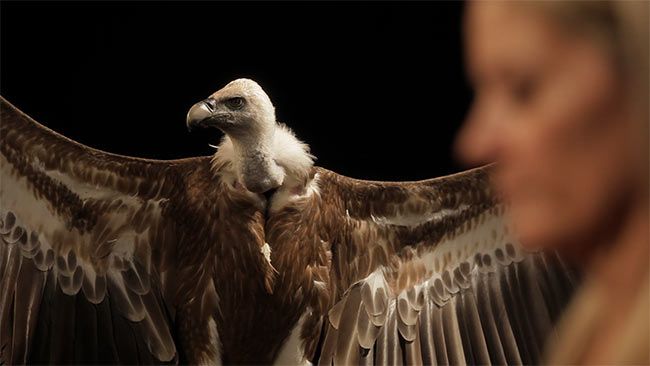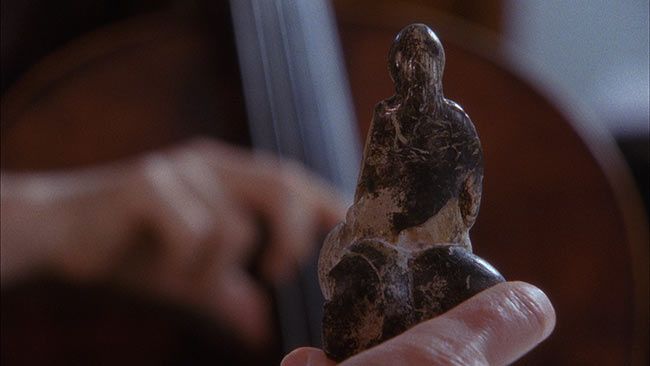Main Building
This exhibition of new and recent projects by Puerto Rico–based artists Jennifer Allora and Guillermo Calzadilla explores music's capacity to evoke an ancestral time and interrogate what makes us human. Through films, sound, live performances, and sculpture, the artists take on various notions of the interval—the time between events, the measure between two points in space, or the range between musical notes—in order to discover possible ways to reconsider the distance between our present and our past. Allora & Calzadilla: Intervals, the artists' largest solo exhibition in the United States to date, unfolds over two sites: the Perelman Building at the Philadelphia Museum of Art and The Fabric Workshop and Museum.
Each Allora & Calzadilla work in this exhibition stems from a cultural artifact or a vibrant remainder from various moments in history, including the oldest musical instrument ever discovered, the remains of nineteenth-century elephants, a prehistoric figurine, or fragmented dinosaur bones. Live choral and orchestral performances reimagine concerts from another century, and an intimate vocal score produces a new friction between human presence and the prehistoric past. As archaeological exercises that unsettle linear time, these provocative works wrestle with the abyss that lies between the human experience and our evolving place within the larger universe.
Films
In the Perelman Building's Julien Levy Gallery, a trilogy of films will be shown in sequence on three screens in an installation designed in collaboration with the artists. Each film emerged from Allora & Calzadilla's rigorous studies of artifacts and a conceptual reconsideration of our possible relationships to them. Taken together, the films continue the artists' exploration of the history and origins of human music and the traditional assumptions about what classifies life-forms as human or animal.
Raptor's Rapture, 2012
HD video
Color, sound
23:30 minutes
Courtesy of the artists
Bernadette Käfer, a flautist specializing in prehistoric instruments, attempts to play the oldest musical instrument found to date: a flute carved by Homo sapiens 35,000 years ago from the wing bone of a griffon vulture. This archaeological artifact brings further evidence of the role of music in the social development, territorial expansion, and evolutionary survival of early humans. Käfer discovers the ancient sound of the flute in the presence of a live griffon vulture, connecting a living descendant to its ancestor through an acoustic trace of prehistoric human culture.
Apotomē, 2013
Super 16mm film transferred to HD video
Color, sound
23:09 minutes
Courtesy of the artists
Singer Tim Storms, who possesses the lowest recorded voice in the world, intonates a subsonic version of the music played in 1798 for two elephants brought to Paris as spoils of the Napoleonic Wars. He slowly walks through the storerooms of the Muséum national d'Histoire naturelle in Paris until he arrives at the elephants' skeletal remains, which he handles while singing. Reaching octaves so low that only animals as large as elephants can hear it, his voice reactivates and recasts interspecies communication through music. The title of the film, Apotomē, is an archaic Greek word that translates literally as "what is cut off" and refers to a musical interval discovered by Pythagoras.
3, 2013
Super 16mm film transferred to HD video
Color, sound
18:22 minutes
Courtesy of the artists
Cellist Maya Beiser plays a musical score by renowned composer David Lang to a prehistoric figurine known as the Venus of Lespugue. The figurine's exaggerated proportions—sometimes interpreted as a symbol of intensified fertility or an icon of a religious deity—also closely match the ancient Greek musical scale known as the Dorian mode. Drawing from the proportions of the Venus, Lang transcribed the figurine into a composition for solo cello, which Beiser performs in a storage room of the Musée de l'Homme in Paris.
Sound Installation
A new sound-based work titled Interludes will play in the Perelman Building's Skylit Atrium as well as at The Fabric Workshop and Museum, connecting the exhibition's physical sites through the ethereal, ephemeral medium of breath. Interludes restores the breaths commonly muted from unmixed vocal recordings, moments that go unheard in final mastered tracks; the work reinserts these sounds into an audio sequence referencing the original composition. This sound project draws from audio recordings from the Sigma Sound Studios Collection of the Drexel University Audio Archives.
Performances
Two performances will be staged in the Skylit Atrium on selected dates throughout the exhibition: A new choral performance, In the Midst of Things, reconstructs Joseph Haydn's oratorio The Creation (1796–98). Haydn's composition is based on the Book of Genesis and John Milton's epic poem Paradise Lost, which opens in medias res, or in the middle of the story. For In the Midst of Things, the artists have embraced Milton's nonlinear approach by subjecting Haydn's work to a series of reversals, inversions, and interruptions. These interventions on the original musical score are mirrored by the singers' physical movements throughout the space, poetically suggesting a reconsideration of time and the origins of humankind. For this performance, Allora & Calzadilla collaborated with The Crossing, a professional chamber choir dedicated to new music and conducted by Donald Nally. A Concert for Elephants revisits a performance on May 29, 1798, in which an orchestra played to two elephants in the Jardin de plantes at the Muséum national d'Histoire naturelle in Paris. Restaging the first documented attempt to use human-generated music to communicate with animals, the performance takes place in both the open space of the Skylit Atrium and in the Levy Gallery, where it specifically intersects with the film Apotomē. For this performance, Allora & Calzadilla collaborated with Relâche, a chamber ensemble dedicated to contemporary music. Additionally, composer Christopher Rountree developed the arrangement and some original music.
Object
Technofossils trace the use of technology over time, from the first tools of early humans to the electronic media of the twenty-first century. Preserved in the archaeological archive, this artifact—a spark plug that became engulfed in fossilized stone as it sat at the bottom of the ocean—acts as an accelerated record of our current geological era. Formed over time yet reflective of our own moment, this technofossil collapses the intervals between past and present, technological progress and obsolescence, manmade materials and natural phenomena.
Also at The Fabric Workshop and Museum
Allora & Calzadilla: Intervals continues at The Fabric Workshop and Museum on 1214 Arch Street in Philadelphia.
The following works will be presented in addition to the sound piece Interludes:
Sculpture and Performance
A new work entitled Lifespan will occupy the first-floor gallery. A Hadean period rock sample, estimated to be more than four billion years old, hangs from the ceiling. During live performances, the rock is "played" by three vocalists whistling and breathing a composition by David Lang, their actions subtly moving the rock like a pendulum. The singers' breaths, acting as a poetic form of wind erosion, bring humans into close contact with this rock sample. Lifespan connects the present moment with that of the earth's origins, a time when there were no witnesses to the planet's geological transformation. Vocalists from the chamber choir The Crossing will perform Lifespan at The Fabric Workshop and Museum seven days a week at 1:00, 2:00, and 3:00 p.m. On Saturdays when performances are scheduled at the Philadelphia Museum of Art, The Crossing will perform this work at The Fabric Workshop and Museum at 3:00 and 4:00 p.m.
Film
On the second floor, a new three-channel video installation, The Great Silence, focuses on the world's largest radio telescope, located in Esperanza, Puerto Rico, which captures radio waves emitted from the edges of the universe. The site of the radio telescope is also home to the last remaining wild population of critically endangered Puerto Rican Parrots, who make their habitat in the surrounding forest. Working with science fiction author Ted Chiang, who contributed the subtitles, the artists explore translation as a device to trace and ponder the irreducible gaps between actors: living and nonliving, human and animal, technological and cosmic.
Installation
Intervals, a new sculptural installation on the eighth floor, presents fragments of dinosaur bones arranged on top of transparent acrylic lecterns, offering a fractured reading of natural history that is potent, yet incomplete. The lecterns are assembled into sculptural monuments, raising each bone fragment to the corresponding height of its original location within the skeleton of the respective animal. These artifacts thus function as three-dimensional primary texts written into the geological record.



